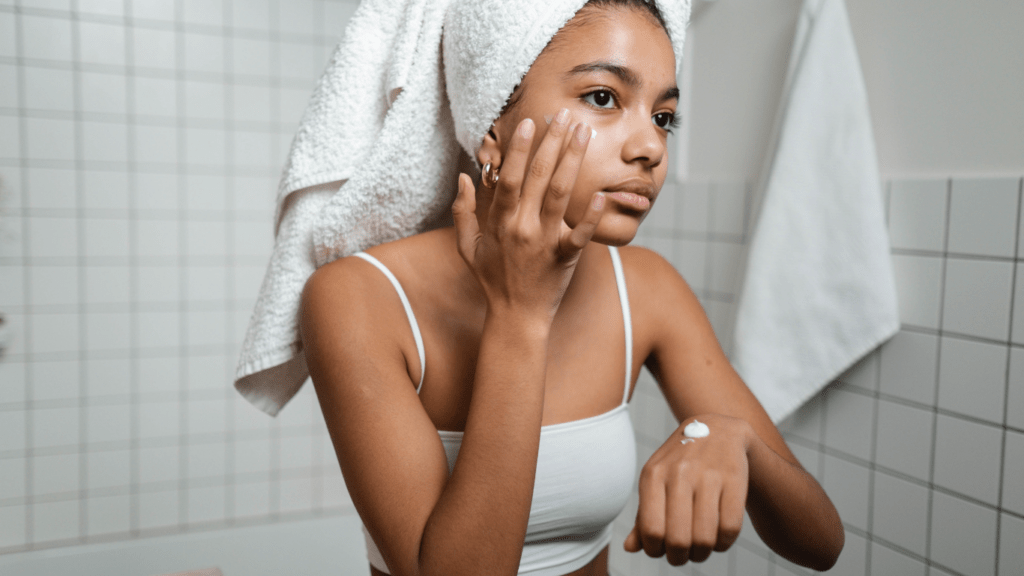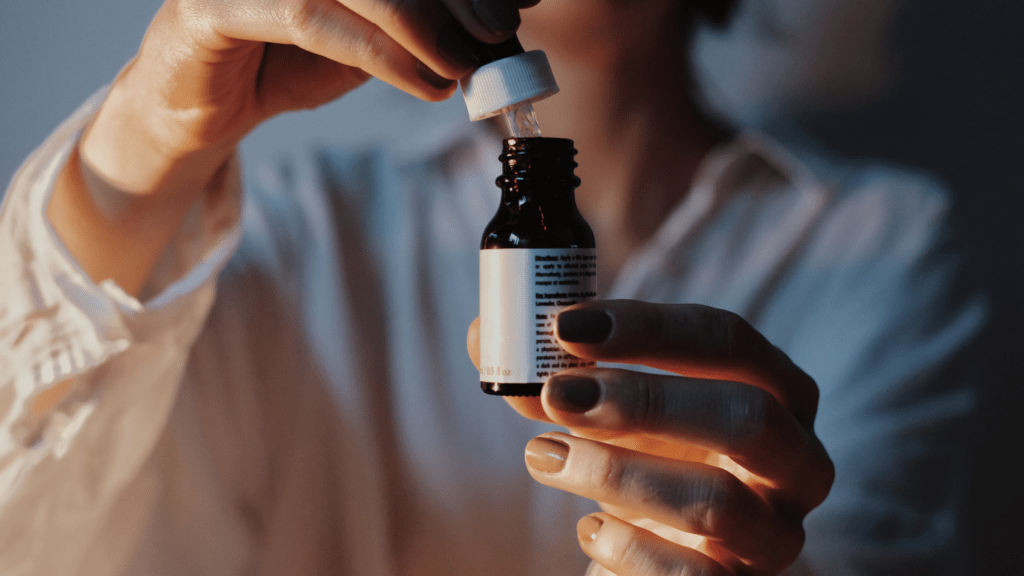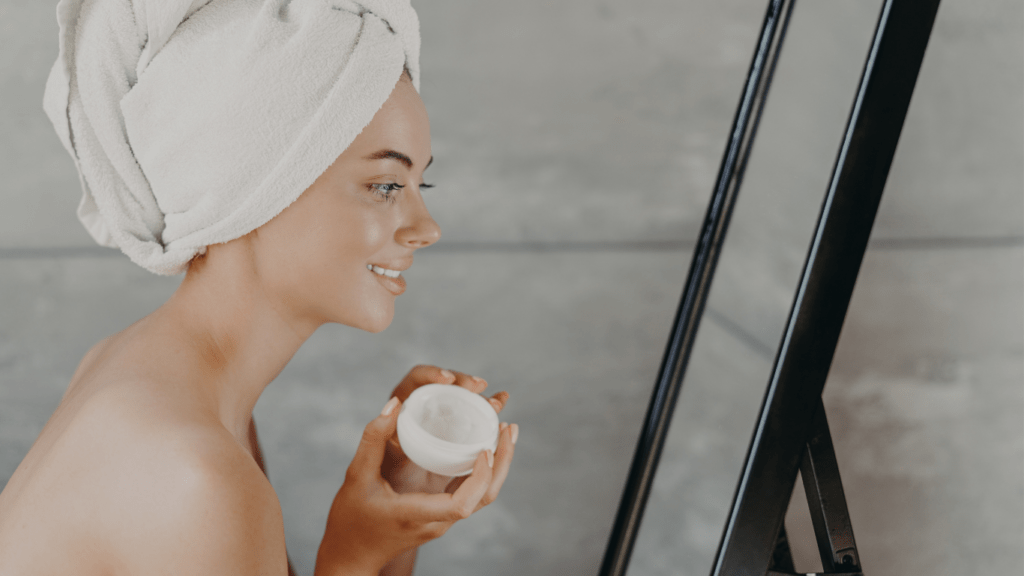Understanding Your Skin Type
Knowing your skin type’s crucial for building an effective skincare routine. This helps in selecting products that match your skin’s specific needs.
Identifying Different Skin Types
There are five main skin types: normal, oily, dry, combination, and sensitive. Each type needs unique care:
- Normal Skin: Even texture, free from major skin issues. Best for a balanced routine with light moisturizers and gentle cleansers.
- Oily Skin: Shiny, prone to breakouts. Requires oil-control cleansers and non-comedogenic products.
- Dry Skin: Rough, flaky texture. Needs intense moisturizers and hydrating cleansers.
- Combination Skin: Oily in the T-zone (forehead, nose, chin), dry on cheeks. Needs balancing products targeting specific areas.
- Sensitive Skin: Easily irritated, redness. Must use hypoallergenic and fragrance-free products.
Understanding your skin type helps in targeting the right concerns and avoiding common issues like irritation and breakouts.
Assessing Your Skin’s Needs
Different factors affect your skin’s needs such as age, environment, and lifestyle. Evaluate the following:
- Hydration: Look for tightness or flakiness. This indicates the need for more moisture.
- Oiliness: If skin appears shiny or feels greasy, oil control is necessary.
- Sensitivity: Note redness or irritation. Choose products with soothing properties.
- Acne: Presence of pimples or blackheads points to a need for blemish control.
Gathering this information ensures your skincare routine addresses specific concerns and evolves as your skin changes.
Essential Skincare Products
Choosing the right skincare products is crucial for maintaining healthy skin. Here are some essential products to include in your routine:
Cleansers
Cleansers remove dirt, oil, and impurities from the skin. Opt for a gentle formula if you have sensitive skin. For oily skin, pick a foaming or gel cleanser to control excess oil. Dry skin benefits from creamy or oil-based cleansers that provide moisture.
Toners
Toners balance the skin’s pH after cleansing. They remove any residual makeup or cleanser and prepare the skin for further treatments. For acne-prone skin, select a toner with salicylic acid. If you have dry skin, opt for a hydrating toner containing ingredients like glycerin or hyaluronic acid.
Moisturizers
Moisturizers keep the skin hydrated by forming a barrier that locks in moisture. Choose a lightweight, oil-free moisturizer for oily skin. Dry skin benefits from thicker, more emollient creams. Combination skin may require different moisturizers for different areas.
Sunscreens
Sunscreens protect the skin from harmful UV rays. Use a broad-spectrum sunscreen with at least SPF 30 every day. For oily skin, choose a non-comedogenic, matte-finish sunscreen. Dry skin may benefit from a moisturizing sunscreen with additional hydrating ingredients.
Serums
Serums deliver concentrated active ingredients to target specific skin concerns. For anti-aging, select a serum with retinoids or peptides. For brightening, choose one with vitamin C. Hydrating serums often contain hyaluronic acid, ideal for dry or dehydrated skin.
Building a Morning Skincare Routine

Crafting a morning skincare routine sets the stage for a day of healthy skin. Specific steps and techniques maximize the efficacy of your skincare regimen.
Step-by-Step Guide
Start with a gentle cleanser. Select a product tailored to your skin type. For example, individuals with oily skin benefit from foaming cleansers, while those with dry skin prefer hydrating cleansers.
Follow with a toner. This balances your skin’s pH and preps it for the next steps. Opt for alcohol-free toners if your skin is sensitive.
Apply serum. Use an antioxidant serum, often containing Vitamin C, to protect against environmental damage and brighten your complexion.
Use an eye cream next. This helps reduce puffiness and dark circles. Gently apply it using your ring finger to avoid tugging at the delicate skin around your eyes.
Moisturize properly. Choose a moisturizer suitable for your skin type. Gel-based moisturizers work well for oily skin, while cream-based ones benefit dry skin.
Finish with sunscreen. SPF 30 or higher shields your skin from UV rays. Reapply every two hours if you’re spending time outdoors.
Tips for Effective Application
Apply products in the correct order. Start with the thinnest consistency, like a serum, and end with the thickest, like a moisturizer.
Pat, don’t rub. Patting helps your skin absorb products more efficiently and reduces irritation.
Use the right amount. A pea-sized amount of serum, a dime-sized amount of moisturizer, and a nickel-sized amount of sunscreen are generally sufficient.
Be consistent. Consistency improves results, so stick to your routine daily.
Customize based on your skin’s reaction. Adjust the frequency of use or switch products if you notice irritation or lack of results.
Building a Night Skincare Routine
Creating a night skincare routine may seem daunting, but following a step-by-step guide simplifies the process.
Step-by-Step Guide
1. Cleanser: Start by removing makeup and impurities with a gentle cleanser. Double cleansing can be effective, using an oil-based cleanser first followed by a water-based one.
2. Toner: After cleansing, apply toner to balance your skin’s pH level. This step prepares your skin to absorb subsequent products more effectively.
3. Serum: Choose a serum that targets specific concerns like anti-aging, hydration, or brightening. Use products containing ingredients like hyaluronic acid, retinol, or vitamin C.
4. Eye Cream: Apply a small amount of eye cream to the delicate area around your eyes. Look for ingredients like peptides and caffeine to reduce puffiness and dark circles.
5. Moisturizer: Hydrate your skin with a moisturizer suited for your skin type. If your skin is dry, use a thicker cream; for oily skin, opt for a lighter gel formula.
6. Spot Treatment: If needed, apply a spot treatment to areas with acne or hyperpigmentation. Ingredients like benzoyl peroxide and salicylic acid can be effective.
7. Facial Oil: Seal in moisture and provide nourishment with a facial oil, particularly if you have dry or mature skin. Oils like rosehip, argan, or jojoba are beneficial.
Importance of Consistency
Consistency is key to seeing results in your skincare routine. Following your routine every night helps maintain skin health and addresses concerns over time. Skipping steps or irregular application reduces effectiveness and prolongs the time needed to see improvements. By consistently applying products in the correct order, you optimize each product’s efficacy and promote a more radiant and healthy complexion.
Common Skincare Mistakes to Avoid
Missteps in skincare can impact your skin’s health and appearance. It’s essential to be aware of these common mistakes to ensure your efforts aren’t in vain.
Over-Exfoliating
Over-exfoliating can damage the skin barrier. Exfoliation removes dead skin cells and promotes new cell turnover, but doing it too often strips natural oils, leading to irritation and dryness.
For example, using physical scrubs or chemical exfoliants more than twice a week can be too harsh. Always listen to your skin; if redness or sensitivity occurs, reduce the frequency.
Neglecting Sunscreen
Neglecting sunscreen increases the risk of sun damage. UV rays can cause premature aging and increase the risk of skin cancer. Sunscreen should be a daily staple regardless of the weather or indoor activities. Dermatologists recommend using a broad-spectrum SPF 30 or higher. Skipping this step can negate the benefits of other skincare products, as the skin needs protection to maintain its health.




